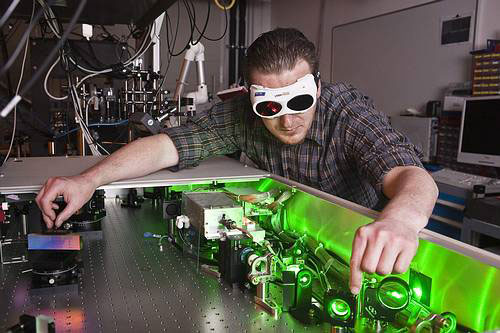| Nov 15, 2010 |
QUEST - Three years of research at the quantum limit
|
|
(Nanowerk News) Since November 2007, the Cluster of Excellence QUEST - Centre for Quantum Engineering and Space-Time Research - at Leibniz Universität Hannover has been supported by the Excellence Initiative of the German federal and state governments. With its main research areas of quantum engineering and space-time research, QUEST is the only cluster of excellence for physics in the North of Germany. QUEST's recently published interim report gives an overview of current research topics and achievements so far.
|
 |
| QUEST researcher adjusting a modern femtosecond laser system for the generation of nanostructures.
|
|
"QUEST does research on a par with top-level international institutions into the most exciting topics in modern physics, mathematics and geodesy," says Stephan Weil, Lord Mayor of Hannover, in his preface. Prof Dr-Ing Erich Barke, President of Leibniz Universität, emphasises that QUEST not only aims to set new technological standards worldwide, but also decisively shapes the science location Hannover. "Both the visionary research projects at the interfaces of mathematics, physics and geodesy and the successful teaching concepts within QUEST play a major role in raising awareness of Leibniz Universität Hannover."
|
|
According to Prof Dr Wolfgang Ertmer, Director of QUEST, the report places particular emphasis on presenting interdisciplinary research, which has been greatly strengthened by QUEST both within Leibniz Universität and also with its partners. Apart from six institutes of Leibniz Universität Hannover, QUEST's partner institutions are the Laser Zentrum Hannover (LZH), the Max Planck Institute for Gravitational Physics (Albert Einstein Institute) with the gravitational wave detector GEO600, the Physikalisch-Technische Bundesanstalt Braunschweig and the Centre of Applied Space Technology and Microgravity (ZARM) at the University of Bremen.
|
|
The main focus of the interim report is on the 24 new research groups and nine interdisciplinary project groups, so-called task groups. The groups give an informative overview of their current research topics, their activities in teaching and promoting young scientists, and national and international collaborations.
|
|
The scientists set themselves high goals right from the start. After a little more than half of the first funding phase they can point to some remarkable achievements. They are participating in current international gravity field satellite missions, and through their work they are already involved in future satellite missions. They are working on transportable atomic clocks for future global satellite navigation systems, or are developing high-precision measuring instruments, so-called atomic interferometers. The development and application of a squeezed light laser in the gravitational wave detector GEO600 demonstrates how physical limits are constantly being overcome. With this laser system, the researchers hope to be able to significantly reduce the natural noise of light, which is a disturbing factor in the evaluation of gravitational wave signals. Many of the ideas developed and tested by QUEST to increase the sensitivity of gravitational wave detectors have been adopted worldwide. The development of novel optical technologies is a fundamental element of the cluster and forms the basis of a major part of the research activities within QUEST. So for example, particularly stable and precise laser systems are being developed, or tailor-made optical technologies are being made available.
|
|
In addition to this, the interim report provides an insight into the cluster's administrative structures, public relations activities, and an overview of programmes created by QUEST to support young students.
|

